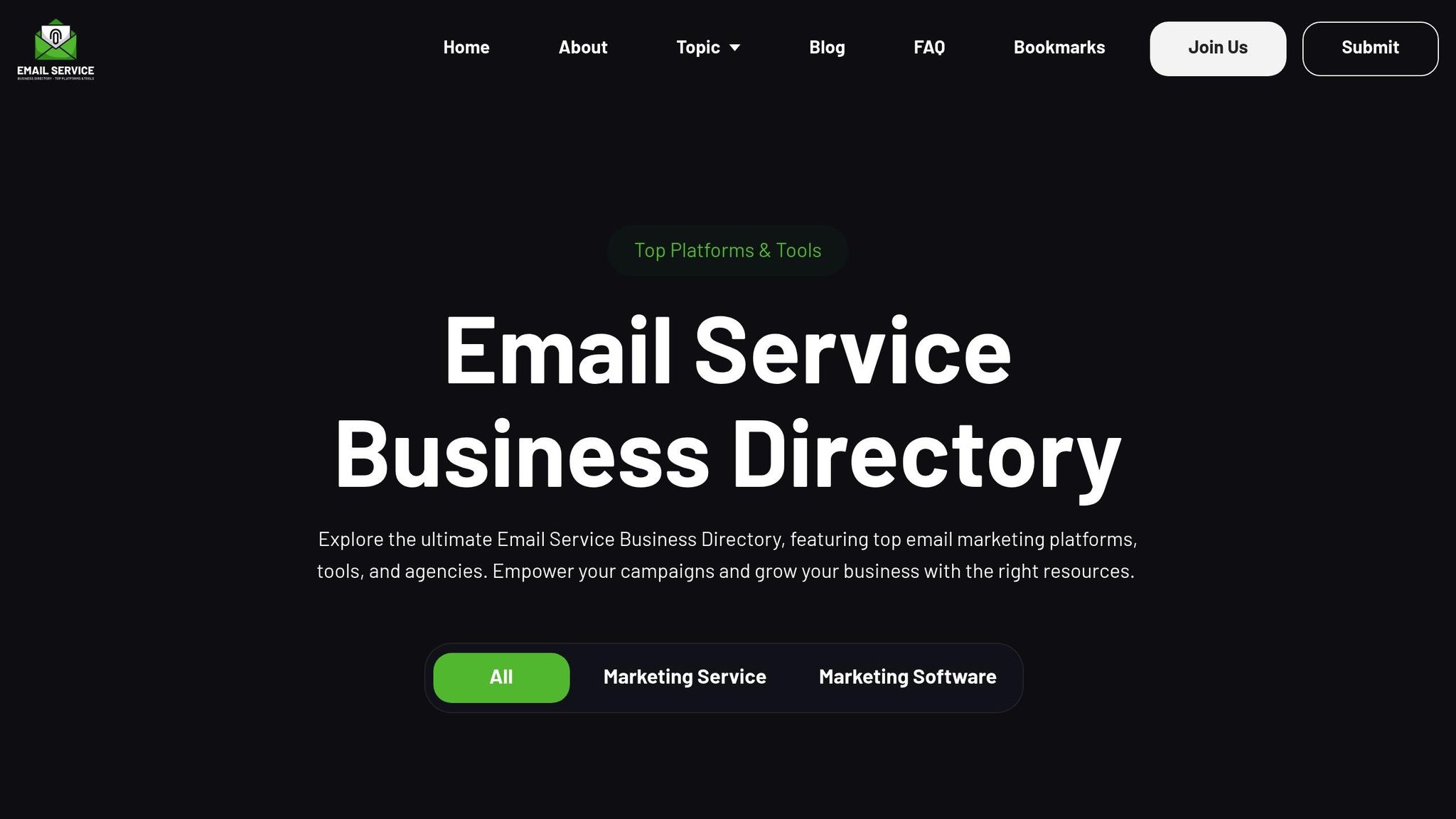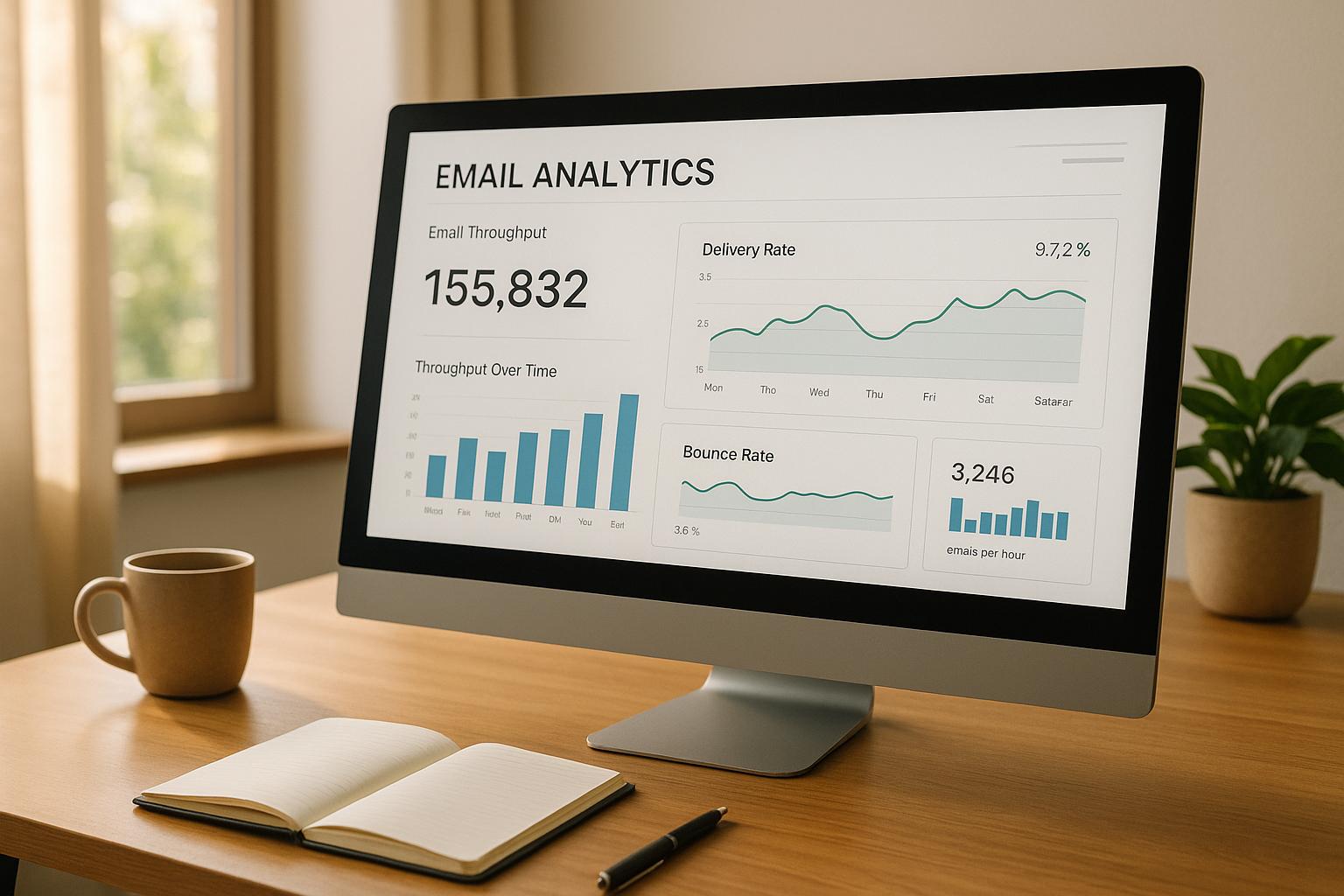Want your email campaigns to deliver measurable results? SMART goals are the answer.
Here’s why: SMART goals help you clearly define what success looks like and how to achieve it. Instead of vague objectives like "improve email performance", SMART goals break it down into actionable steps.
What makes a goal SMART?
- Specific: Focus on one clear outcome (e.g., "Increase newsletter open rates").
- Measurable: Use numbers to track progress (e.g., "Boost open rates from 20% to 30%").
- Achievable: Set realistic targets based on your resources and past performance.
- Relevant: Align goals with broader business objectives, like driving sales or engagement.
- Time-bound: Add a deadline to stay on track (e.g., "Achieve this within 90 days").
SMART goals keep your email strategy focused, making it easier to measure success, allocate resources, and adjust tactics based on data. For example, if your goal is to grow your subscriber list, you might aim to add 2,500 new emails in 3 months using pop-ups and referral campaigns.
Why does this matter?
Without SMART goals, campaigns lose focus, and results are hard to measure. But with them, you can:
- Track what’s working using metrics like click-through rates or conversions.
- Align email efforts with business priorities (e.g., increasing revenue or reducing churn).
- Communicate clear, data-backed results to stakeholders (e.g., "15% boost in open rates").
When setting SMART goals, rely on historical data to make realistic targets and use tools like email marketing platforms to track your progress. Whether you’re aiming to improve open rates, increase click-throughs, or grow your audience, SMART goals provide a clear path to success.
How To Set SMART Goals for Effective Marketing Campaigns
Aligning Email Campaign Goals with Business Objectives
When email campaigns align with your business goals, they become a powerful tool for driving measurable growth. The key is to connect your email marketing efforts directly to your company's priorities, ensuring every campaign delivers meaningful results.
Clear alignment brings focus and measurable returns, while misaligned efforts can waste time and resources.
How to Map Email Goals to Business Priorities
To align your email marketing with business objectives, the SMART framework is a great starting point. First, identify your company’s top priorities for the next quarter or year. These might include goals like increasing revenue, reducing customer churn, entering new markets, or improving customer satisfaction. Once you’ve pinpointed these priorities, create email-specific goals that directly support them.
For example, if boosting revenue is a primary focus, your email campaigns might aim to drive repeat purchases or promote higher-value products. On the other hand, if retaining customers is critical, your goals could include re-engaging inactive subscribers or strengthening relationships through targeted content.
Work backward from your desired outcomes. Ask yourself: What role should email marketing play in achieving each goal? This reverse-engineering approach ensures your campaigns are designed to make a real impact.
Consider your customer lifecycle to pinpoint where email can have the greatest influence. For instance, a business focused on lead generation might use email to nurture prospects through the sales funnel. Meanwhile, an e-commerce company could use email to encourage more frequent purchases and boost customer lifetime value.
Rather than spreading your efforts thin across loosely defined campaigns, concentrate on initiatives that directly support your top priorities. This targeted approach ensures your resources are used effectively.
Examples of Business-Driven Email Goals
Here’s how email goals can align with specific business objectives:
- Increasing Customer Lifetime Value: Encourage repeat purchases with personalized product recommendations and follow-up emails tailored to individual preferences.
- Lead Generation and Sales Qualification: Build a steady pipeline of marketing-qualified leads by nurturing prospects through an educational email series.
- Market Expansion: Grow your subscriber base in a specific region using lead magnets or referral campaigns to attract new audiences.
- Customer Satisfaction and Engagement: Enhance satisfaction by sending regular feedback emails and timely follow-ups after customer interactions.
- Seasonal Revenue Optimization: Plan promotional email sequences around seasonal trends to maximize revenue during key periods.
These examples highlight how aligning email goals with business priorities not only secures budgets and resources but also demonstrates measurable value to leadership. By tying your campaigns to clear objectives, you create a cycle of growth and success while reinforcing the SMART framework throughout your email strategy.
Step-by-Step Guide to Defining SMART Goals for Email Campaigns
Defining SMART goals for your email campaigns is all about turning vague ideas into clear, measurable targets. By focusing on the right metrics, applying the SMART framework, and leveraging your historical data, you can set goals that are both ambitious and achievable. Here's how to choose the right metrics and set meaningful targets for your campaigns.
Choosing the Right Metrics for Your Campaign
The success of any SMART goal starts with selecting metrics that align with your campaign's purpose. The type of email you're sending and your overall objective will determine which metrics matter most.
Align metrics with your campaign's purpose. For example:
- If your goal is to drive sales through a promotional email, focus on conversion rates and revenue per email.
- For a newsletter aimed at engagement, prioritize open rates and click-through rates.
- A welcome series for new subscribers might focus on engagement metrics and unsubscribe rates.
The AgencyAnalytics Marketing Agency Benchmarks Survey highlights that conversion rate is often the most important metric for clients. And it’s no wonder - email campaigns typically deliver an impressive return of $36 for every $1 spent, equating to a 3,600% ROI.
Focus on metrics that reflect real impact. Metrics like revenue per email, lead conversions, and engagement rates provide deeper insights than surface-level numbers like total opens or clicks. For instance:
- A flash sale email should prioritize conversion rates and total sales.
- A monthly newsletter might emphasize engagement metrics, like time spent reading or social shares.
Once you've identified the right metrics, the next step is to turn them into a clear SMART goal.
Creating SMART Goals: A Practical Example
Turning a vague goal into a SMART goal requires breaking it down into specific, measurable, and actionable components. Let’s walk through an example:
Vague Goal: "Improve our email marketing performance."
This lacks clarity, measurable criteria, and a timeline. Here's how to refine it using the SMART framework:
- Specific: Clearly define the objective. For example, "Increase click-through rates for our monthly product newsletter."
- Measurable: Add precise numbers. "Increase click-through rates from 2.1% to 3.5%."
- Achievable: Make sure the target is realistic. A jump from 2.1% to 3.5% represents a 67% improvement - ambitious, but possible with focused efforts.
- Relevant: Tie the goal to broader business objectives. "Increase click-through rates to drive more traffic to product pages and support Q2 sales targets."
- Time-bound: Set a deadline. "Achieve this improvement within 90 days."
Final SMART Goal: "Increase the click-through rate of our monthly product newsletter from 2.1% to 3.5% within 90 days to drive more qualified traffic to our product pages and support Q2 sales targets."
With this, you have a clear target and timeframe for measuring success.
Using Historical Data to Set Realistic Targets
Once you've defined your metrics and goals, use historical data to ensure your targets are achievable. Your past performance provides a reliable foundation for setting goals that balance ambition with realism.
- Establish your baseline. Analyze six months of data to identify your average performance. For example, if your click-through rate has been 2.1%, use this as your starting point.
- Track natural growth trends. If your email performance has improved by 5% annually without major changes, you can use this as a baseline for future growth.
- Factor in planned improvements. If you're introducing changes like better segmentation or enhanced email design, estimate the additional lift these strategies might provide. For instance, combining historical growth (10%) with a new personalization strategy (5%) could justify a 15% improvement target.
- Use forecasting models. Create spreadsheets to project different outcomes based on historical data. This helps account for factors like seasonal trends or market shifts.
- Address underperforming areas. Focus on metrics where past campaigns fell short. For example, if your open rates are strong but click-through rates lag behind, set a SMART goal to improve CTR specifically.
sbb-itb-6e7333f
Common SMART Goal Examples for Email Campaigns
To make your email campaigns more effective, it helps to break down your objectives into focused, actionable SMART goals. Below, we’ll explore how to apply this framework to common email marketing metrics, turning broad ambitions into specific, measurable targets that drive real results.
Boosting Open Rates
SMART Goal Example: "Increase our weekly newsletter open rate from 32.55% to 38% within 60 days by implementing A/B testing on subject lines and optimizing send times based on subscriber behavior data."
This goal is grounded in the current open rate of 32.55%, aiming for a realistic yet ambitious improvement through targeted strategies.
Here’s how to make it happen:
- Test 3-5 different subject lines each week to identify what resonates most.
- Analyze subscriber behavior to pinpoint the best times to send emails.
- Segment your audience by factors like time zone and engagement history to tailor delivery.
Growing Subscriber Lists
SMART Goal Example: "Add 2,500 new qualified email subscribers within 90 days by implementing discount-based pop-ups on our website and launching a referral program."
Growing an email list isn’t just about numbers - it’s about attracting subscribers who are genuinely interested in your content or offerings. This goal uses proven tactics, such as discount-based pop-ups, which boast an average 43% conversion rate, and referral programs to attract high-quality subscribers.
Key strategies to achieve this include:
- Focus on quality: Verified email lists can lead to a 2,270% increase in conversion rates.
- Mix incentives: Combine discount offers (43% CVR) with exclusive access (25% CVR) and giveaways (11% CVR).
- Add interactive elements: Features like Spin-to-Win sign-up units can triple subscriber growth.
By driving around 5,814 visitors to your sign-up forms over 90 days, you can expect to hit the target of 2,500 new subscribers.
Improving Click-Through Rates
SMART Goal Example: "Increase click-through rates on our monthly product showcase emails from 2.8% to 4.2% within 45 days using segmentation and personalized recommendations based on past purchases."
This goal focuses on using personalization and segmentation to improve engagement. With a 45-day window, you can implement these strategies and gather valuable insights:
- Segment your audience based on purchase history, browsing behavior, and engagement levels.
- Use dynamic content blocks to showcase products tailored to each subscriber’s past purchases.
- Incorporate automated relationship-building emails, which achieve 84% higher open rates than standard campaigns.
- Experiment with different call-to-action placements and wording to find what drives clicks.
Given that 87% of B2C marketers already use email automation, this approach leverages proven tools to maximize results.
These examples show how SMART goals can transform vague objectives into clear, actionable plans. By aligning metrics with your business priorities and using tested strategies, you can set targets that are both challenging and achievable.
Tools and Resources for Setting and Tracking SMART Goals
Turning ambitious email marketing goals into measurable results requires the right tools. While setting SMART goals gives you a clear framework, you need platforms that help track progress, automate tasks, and deliver critical analytics. The right email marketing solutions can bridge the gap between planning and execution, ensuring your strategy stays on course.
How the Email Service Business Directory Helps Achieve SMART Goals

The Email Service Business Directory offers a curated list of email marketing platforms designed to support SMART goal achievement. Instead of spending weeks researching tools, this directory simplifies the process by showcasing platforms tailored to manage and optimize email campaigns effectively. By aligning platform features with your SMART objectives, you can streamline your workflow and track performance with ease.
For example, if your goal is to improve open rates or grow your subscriber list, you'll need platforms with real-time dashboards that track metrics like open rates, click-through rates, subscriber growth, and conversions. These insights are essential for monitoring progress and adjusting strategies as needed.
Automation plays a key role in meeting time-sensitive goals. Many platforms in the directory offer features like automated drip campaigns and abandoned cart recovery sequences. These tools allow you to run campaigns that align with your objectives - even when you're not actively managing them - helping you stay on track with your timelines.
Additionally, the directory highlights platforms with powerful segmentation tools. These features let you tailor messages to specific audiences, whether based on demographics, behavior, or engagement levels. By delivering personalized content, you can drive better results and make your SMART goals actionable.
Comparing Tools for Managing SMART Goals
Different email marketing platforms excel in specific areas, and choosing the right one depends on your campaign goals. The Email Service Business Directory organizes platforms by their strengths and target audiences, making it easier to find a solution that fits your needs. Here's a comparison of tools based on common email campaign objectives:
| Goal Type | Essential Features | Notable Features | Pricing Range |
|---|---|---|---|
| Open Rate Improvement | A/B testing, send time optimization, subject line analysis | Advanced testing capabilities, detailed analytics | $299–$999/month |
| Subscriber Growth | Landing page builders, pop-up forms, referral tracking | Strong lead generation tools, integration options | $299–$2,999/month |
| Click-Through Enhancement | Dynamic content, personalization engines, heat mapping | Advanced personalization and content optimization | $999–$2,999/month |
For small businesses with fewer than 1,000 subscribers, the directory features affordable options starting at $299 per month, offering basic analytics and automation. Businesses with 1,000 to 10,000 subscribers often need more robust tools, with mid-tier solutions around $999 per month providing enhanced automation and analytics. Enterprise-level organizations with complex campaigns can benefit from top-tier platforms priced at approximately $2,999 per month, which include advanced features and priority support.
When evaluating platforms, pay close attention to deliverability rates and integration capabilities. High deliverability ensures your emails land in your subscribers’ inboxes, while seamless integration with your CRM, e-commerce platform, or analytics tools makes it easier to track progress and achieve your SMART goals efficiently.
Conclusion: Defining SMART Goals for Email Campaign Success
Setting SMART goals turns email marketing into a focused and measurable effort. This approach ensures every campaign has a clear purpose, defined outcomes, and accountability that ties directly to your business goals. By making your goals specific, measurable, achievable, relevant, and time-bound, marketing teams stay on track and can clearly demonstrate ROI to stakeholders.
Here’s a powerful stat: segmented email campaigns can generate up to 760% more revenue than non-segmented ones. That’s why having precise targets, like "increase open rates from 25% to 35% through A/B testing and optimized send times over three months," can make a huge difference.
Once your goals are set, the next step is choosing the right tools to hit those targets. Tools matter. The Email Service Business Directory offers detailed comparisons of email platforms, helping you match features with your budget and objectives. It’s all about finding the perfect fit for your SMART goals.
But success doesn’t stop there. Continuous optimization is key - analyzing historical data and regularly reviewing your goals ensures they align with changing business needs. When you combine the SMART framework with the right tools and a commitment to refinement, your email campaigns shift from being just another marketing activity to becoming a major driver of business growth.
FAQs
How can I set SMART goals for email campaigns that align with my business objectives?
To set SMART goals that match your business objectives, focus on making them Specific, Measurable, Achievable, Relevant, and Time-bound. For instance, if your aim is to grow revenue, a related email campaign goal could be increasing email-driven sales by 15% over the next quarter.
Ensure these goals tie into larger company priorities, like boosting customer engagement, improving retention rates, or generating leads. Regularly evaluate your campaign's performance to see if it’s helping drive overall business growth. If needed, tweak your strategy to stay aligned with your objectives. By keeping your goals clear and connected to the bigger picture, your email marketing can deliver impactful results.
What are the key metrics to consider when setting SMART goals for email campaigns?
When creating SMART goals for your email campaigns, it's essential to zero in on metrics that directly reflect your objectives and help you gauge success. Here are some of the most commonly tracked metrics:
- Open rate: This tells you the percentage of recipients who actually opened your email. It’s a solid indicator of how compelling your subject lines and sender name are.
- Click-through rate (CTR): This measures the percentage of recipients who clicked on links in your email, showing how engaging your content is.
- Conversion rate: This tracks the percentage of recipients who completed a specific action, like making a purchase, registering for an event, or downloading a resource.
- Bounce rate: This represents the percentage of emails that never reached the recipient’s inbox, often due to invalid addresses or full mailboxes.
- Unsubscribe rate: This shows the percentage of people who chose to leave your email list after receiving your message.
For instance, a SMART goal could look like this: increasing your open rate by 15% over the next three months or achieving a 20% click-through rate for a particular campaign. These metrics are not only specific and measurable but also directly tied to your campaign’s performance, giving you clear insights to refine your approach and improve results.
How can I use past data to set realistic SMART goals for my email campaigns?
To craft meaningful SMART goals for your email campaigns, begin by diving into your past performance metrics - things like open rates, click-through rates, and conversions. These numbers can reveal trends and benchmarks that help you set targets that are specific, measurable, and realistic.
It’s also a good idea to examine historical customer engagement and buying patterns. This ensures your goals stay relevant and fit within a specific timeline. When you base your objectives on actual data, you’re more likely to create clear, actionable goals that align with your broader business strategy.


